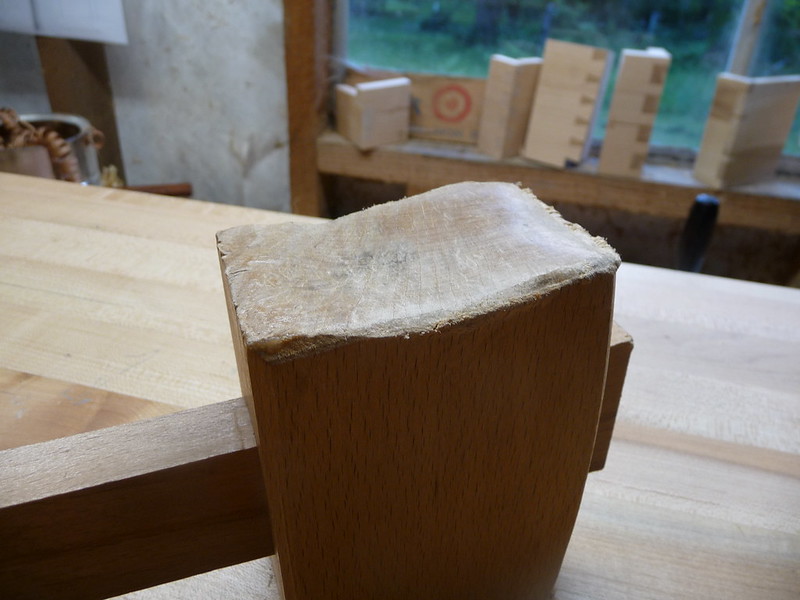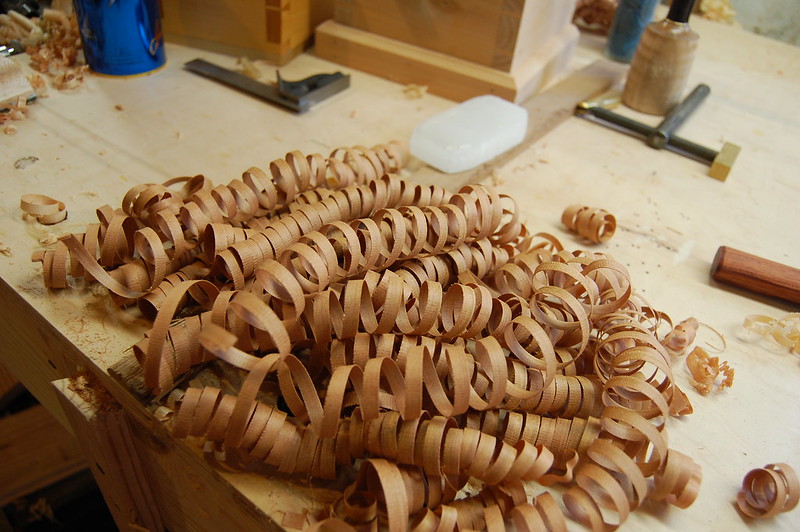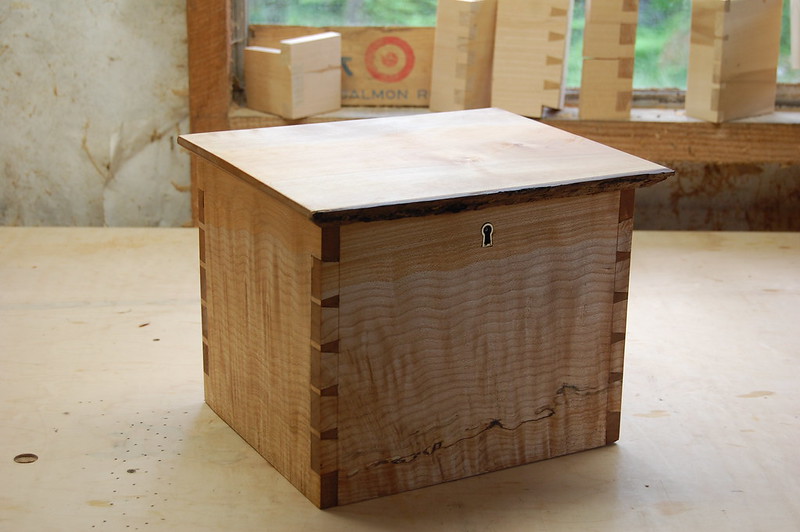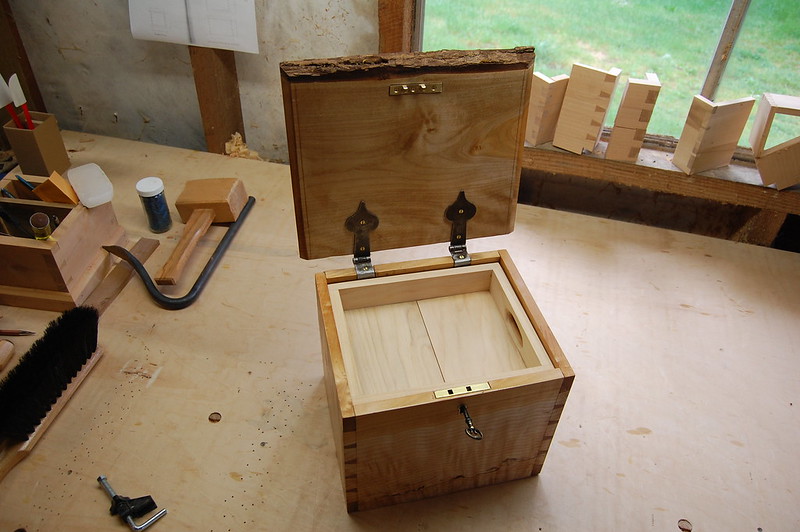TJA: How long have you been woodworking, and what changes have you seen in the field since you started?
JC: I became interested in woodworking in 1999, so almost 13 years. My interest was born out of a need to build some custom furniture pieces to support a completely unrelated hobby, aquaria. Specifically, I needed to build some wide, deep cabinets to hold fish tanks, something I couldn't find in any store. I decided to build them myself. I found plans for a cabinet that would meet my requirements in a basic woodworking book published by Stanley. This introduced me to hand tools and from there it was a quick descent down the hand tool slope. At the time hand tools fit very well into my "shop" environment which consisted of a workbench in a corner of the living room in our townhouse condo.
When I became interested in woodworking much of the mainstream woodworking publications, TV shows, and Internet discussion was still focused on power tools. The rec.woodworking Usenet group was not a friendly place towards "Neanderthals". I came across the OldTools email list and found my new home. Today the environment is much different, perhaps even the polar opposite. Hand tools are very much in vogue and many new woodworkers are starting off as handtool-only woodworkers. Today there is also much more information available for hand tool woodworkers, and many more hand tool makers creating quality tools.
TJA: What is your favorite style to work in? what styles do you just not understand or have no interest in?
JC: I'm not terribly creative or artistic. I don't carve well so I avoid the heavily carved/ornamented styles. I like straight lines and right angles. I like shaker style furniture and I aspire to learn enough to work in the federal style- string inlay is on my list of things to try one day. I do enjoy turning, both spindle and faceplate. I'm also very interested in "rustic" or green woodworking. I recently discovered some early Roy Underhill episodes which totally changed my outlook on woodworking and gave me a new appreciation for his style of work.
TJA: What tools do you always look forward to using and/or what operations do you most look forward to, time after time?
JC:I have a few tools that I always look forward to using: My Lie-Nielsen 4 1/2 heavy smoother (aka the engagement plane) which is the finest handplane I've had the pleasure to use. I also enjoy using my Harvey Peace No. 60 crosscut saw, a rare saw I recently had restored. It's an amazing saw- easy to use and accurate enough to split a pencil line yet it tears through stock very fast. Finally, I think my favorite tool to use is my Varvill & Son plow plane. It's a prototypical late-1800s British screw-arm plow full of all sorts of unnecessary ornamentation and engineering and it performs superbly. It's one of those tools that you pick up and think it was made specifically for your hand.
As for what operations I look forward to- I enjoy cutting joints that require no glue or fasteners to hold them- draw-bored mortise and tenons, wedged through tenons, and dovetails have a sort of magical quality to me (when I cut them correctly!). I would swear that the wedged tenons in my saw bench couldn't be pulled apart by two tanks. It's an amazingly strong, yet simple joint.
TJA: How much time do you actually get in your shop in a typical week?
JC: I have a lot of responsibilities that eat into any potential shop time. Even so, I usually spend two or three nights a week in my shop, and a few lunch breaks as well. So, all told, I probably get 8-12 hours a week in my shop. Most of that time is spent cleaning and restoring tools that I will eventually sell, not working wood, unfortunately. I do have a couple of ongoing projects, including restoring an old joiner's toolchest, that I try to work on from time to time. Those few moments when I'm actually able to work wood for the sheer pleasure of it are incredibly valuable to me.
TJA: Have you had any memorable masters or mentors help you gain the skills you currently possess? How did you meet them?
JC: When I first became interested in hand tool woodworking I took some classes taught by Ian Kirby at a local Woodcraft. I wouldn't call him a mentor, but watching him work was certainly a learning experience. He showed me what a hand plane was capable of doing in the hands of a master woodworker. I also took classes with Garrett Hack and Mario Rodriguez, both of whose work I greatly admire and respect. Recently my main influences have been Christopher Schwarz (of course) and Roy Underhill. I admire Chris' dedication to both woodworking and tools, as well as the way he presents his topics. He's probably the most influential person in the woodworking industry today. Roy is.. just Roy.. I think he's the closest thing I have to a hero at this point in my life. I've spent a lot of time over the last five years or so trying to go back and watch as many old episodes of his as possible. The recent news from Popular Woodworking that the early seasons of The Woodwright's Shop will be re-released soon was just amazing. I can't wait to get my hands on them.
TJA: You focus on rescuing old tools and finding new homes for them, but you obviously know your way around actual woodworking as well. How much of your time goes into building things (or merely testing tools) and how much is dedicated only to the cataloging, researching, and restoring the old tools you find?
JC: These days I think at least 95% of my free time (i.e. time not spent working my day job, playing with my kids, or sleeping) is spent on my tool business, and tasks related to it, leaving less than 5% of my free time for personal things like woodworking or my other hobbies. Most of my time is spent responding to emails, fulfilling requests for specific tools, while preparing my next list of tools for sale. I do spend some of that business time restoring, tuning, and testing tools, all of which I enjoy a lot. Actually, I enjoy all aspects of the tools business immensely. I'm very lucky to be able to pay the bills while doing something I love.
TJA: Have you considered writing about tools? Your knowledge is literally encyclopedic.
JC: I like the idea of writing about tools but I'm not very confident in my writing ability. Writing is not something I excelled at in school. It wasn't until I resumed my college education later in life that I began to take writing seriously. Even though I constantly try to improve my writing I'm still not entirely comfortable writing for the public.
Having said that, I do have a blog on my website, as well as a number of old-tool related articles. A few months ago I wrote an article on the Harvey W. Peace Company for a local tool club's newsletter, which was my first "published" work. I have a long list of ideas for articles for my site. I just lack the time to execute them!
TJA: The book The Anarchists Tool Chest has sent hordes of readers looking for vintage tools in good shape. Have you felt these ripples in your business? Have you ever considered creating an entire collection of Joiners Tools to sell as one whole lot?
JC: I've felt more than a few ripples from the impact The Anarchists Tool Chest. The increase in business I have seen has been nothing short of amazing. That book has had an amazing impact in the level of interest in old tools in general. When the book was first published I had an initial surge in inquiries through my website. Actually, I first learned that Chris mentioned my business in this book when the first round of emails started coming in. Ever since then I've seen a steady and constant stream of new folks who heard about me from the book.
Putting together a "hand tool starter" kit is an idea I kicked around for a while but never decided to try. I see a few problems there- first, the cost of such a kit would be fairly high and would probably not appeal to someone who is just getting started in woodworking. There would also be some limiting factors in term of actually finding the tools. For example, I almost always have a good selection of chisels on-hand yet I always have a hard time finding decent jack planes for some reason. Another factor against this is the issue of personal preferences. If I put together a starter kit of joiner's tools each and every one of those tools has to appeal to the user's personal preference of size, vintage, maker, etc. It would be hard to put together one set of tools that would please everyone. Finally, the idea is sort of at odds with what I preach to new woodworkers. I frequently hear from folks who want to get started and have a list of tools they have to have before they can even start to think about working wood. My advice to them is to start with the basics- a chisel, saw, mallet, some measuring and marking tools, and make something. You can make a basic workbench with not much more than that. (I also disagree with the trend that a woodworker's first project should be an uber-workbench, but that's a another question) That way you start building skills and learning what tools you need as you go and as part of that process you are making things- that's the whole point, to make things. Then again, there are a lot of people for whom all the enjoyment comes from setting up a dream shop chock full of tools but never make anything. There's no harm in that at all- it's called collecting :)
TJA: What else you enjoy outside of woodworking/toolmongering and time with your family?
JC: I have way too many hobbies. I love to garden, both ornamental plants and vegetables. I like to cook, which fits in well with the gardening. I recently started brewing beer which is a lot of fun and something I want to pursue more seriously in the future. I love to read, but have no time to actually sit down with a book. Instead I listen to audiobooks while cleaning, photographing, and packing tools. My main interests are Sci-Fi (both good and bad) as well as fantasy and historical non-fiction. I'd love to learn more about blacksmithing but that project has been put on hold for a while. I also love cycling though these days I've been relegated to being a spectator on TV rather than out there riding. My oldest daughter is just old enough to start playing sports so I'm active in her t-ball and soccer teams. Oh, we heat our home with wood so that's sort of a hobby in and of itself and keeps me busy moving piles of wood around which is fun in its own way.
TJA: What is happening in the hand tool world (toolmakers, blogs, books,projects) that you think need more press?
JC: There's a lot of really interesting stuff going on in the hand tool world.. I think the past three or four years has seen the rebirth of the handsaw. There's an incredible amount of interest in saws- making, restoring, and collecting them. There are some great new saws on the market these days. There are also a number of talented new sawsmiths out there doing fantastic work getting old saws back into usable condition. As a result of all this interest, the market for good used saws has exploded. Because of this, finding decent saws (which was never easy) at reasonable prices is getting much harder. eBay isn't helping that much either. Don't get me started on eBay.
I think that after the Anarchist's tool chest, the book that had the most impact was Follansbee and Alexander's book on joint stools. I know I personally received a number requests for green woodworking tools like hewing hatchets from folks who read the book. I wish I had more to provide! The next big book I think will be Matt Bickford's book "Mouldings in Practice" It will be a first of its kind I think, describing not only how the planes work but gives step by step instructions on actually using them. A lot of people think molding planes are too complicated or difficult to use, and they aren't. I think this book should help demystify these tools and should result in a surge in interest in them.
Aside from that, I'm eagerly looking forward to Popular Woodworking's making available the early seasons of The Woodwright's Shop. I think this will have a significant impact on anyone who sits down and watches the first complete first season. It's truly inspirational stuff and I predict it will have just as much impact as The Anarchist's Toolchest did on woodworking. I think we'll see a surge in interest in green woodworking, and a new appreciation for the tools involved in that sort of work.
TJA: Are you a dog person or a cat person? Does this reflect on your approach to tool collecting?
JC: My business name is the Hyperkitten Tool Company. Does that answer your question? The origin of the name is a long story, but I do have cats at home including the Hyperkitten herself (aka Gwen who, at nearly 13 years old, is no longer a kitten) as well as a rabbit and many fish. I like dogs, but they are too much work right now. I envision my son or youngest daughter someday convincing me to get a dog. Anyhow, I don't think it's had much of an affect on my woodworking, other than the fact that cats love to chase curly shavings around the shop.
TJA: Thank you, Joshua!










